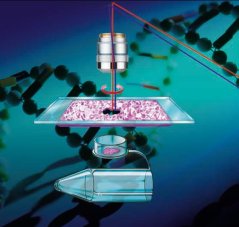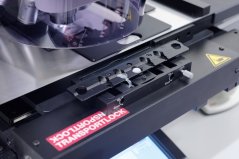
Nieuws
Laser microdissection coupled with RNA-seq analyses to unravel plant-microbe interactions
To understand biological processes it is becoming increasingly important to analyse transciptional responses at the resolution of single cells or cell-types. This is also of key importance in plant-microbe interactions where a limited number of plant cells is in contact with an infecting microbe and different infection or developmental stages are present within the same tissue. Key examples studied at the Laboratory of Molecular Biology are the agriculturally and ecologically important symbiosis between plants and arbuscular mycorrhizal fungi and the nitrogen-fixing symbiosis between legumes and rhizobia.
To study which plant genes as well as microbial genes are active at different stages of these interactions a method was needed to specifically isolate the different cell types free of contamination. Therefore, a state-of-the-art Leica LMD7000 Laser Microdissection (LMD) system that is available through the Shared Research Facilities of Wageningen University & Research was used.
Contact-free isolation of specific cells
The LMD7000 system allows the contact-free isolation of specific cells from nearly any biological system and is especially useful for biological systems where other techniques to isolate specific cell-types, which often require the ability to generate transgenic reporter lines, are not/less feasible. As LMD can be used to isolate cells based on morphological and structural properties it has the advantage that specific markers are not required. Subsequently, biomolecules (DNA,RNA, protein or metabolites) can be extracted and used for downstream analyses.
A key step in the isolation of cells is to obtain semithin sections of the tissue while maintaining the cellular morphology and preserving RNA quality. Fixation using Farmer’s fixative and embedding in low melting Steedman wax gives best results in terms of quality (morphology) of the tissue sections and RNA quality in plant roots and nodules. Alternatively cryosections can be used, which offer a good RNA quality, but for plant cells generally result in a lower quality of morphology due to presence of large vacuoles. Several microtomes are available via the Wageningen Light and Electron Microscopy Centres that can be used by users to make sections.
Next, 12 - 16 µm sections from mycorrhized roots or nodules were mounted onto PEN-membrane frame-slides (Leica), which allow the photo-cold ablation of cells (and membrane) after which the dissected cells are collected by gravity into the cap of an Eppendorf tube. After mounting the sections the Steedman wax is removed in 100% ethanol, air-dried and ready to use for laser microdissection.


User and interface
The LMD7000 has a user friendly interface which allows the selection of individual cells (or even subcellular structures) in a completely automated fashion, facilitated by a touchscreen to mark your cells of interest. Various objectives (5x up to 63x) are available to allow the precise selection of cells. Operators can easily adjust laser power, aperture and speed for the most precise cutting performance for the tissue types of interest. The LMD7000 has sufficient power to cut through wood, etch glass slides or ablate cells. Furthermore, the LMD7000 is equipped with a fluorescence module that allows the selection of cells based on fluorescence, for example through immunostaining.


RNA extraction and analysis
1000-2000 cells of interest were collected for subsequent RNA extraction using the Qiagen RNeasy Plant Microkit, generating ~200 pg - 1ng of total RNA depending on the cell type. On average a single eukaryotic cell contains around 30 pg of total RNA and different cell types can be isolated at the same time from a single tissue section.
To obtain sufficient RNA for RNAseq analysis the isolated RNA was successfully amplified using the Smart-Seq Ultra Low Input v4 RNA kit for sequencing (Clontech), in collaboration with Wageningen Plant Research Bioscience, from as low as ~200 pg of total RNA from laser microdissected root cells. The amplified RNA was subsequently used for library preparation and Illumina HiSeq2500 sequencing. Validation of the obtained RNAseq data confirmed the cell-specific transcriptome data from both plant and microbial symbiont. These data are now giving valuable genome-wide insight into the transcriptional responses of both the plant as well as the microbes during different stages of the interaction.
Laser microdissection
This study shows the power of laser microdissection coupled with high throughput transcriptome analyses to obtain insight into a biological process at a very high resolution. Therefore laser microdissection will be a valuable application for many fields of biology. In addition to DNA/RNA analyses, the LMD7000 system can be used to isolate specific cells types for proteomic or micro-metabolomic studies. It can further be used to isolate living cells from cell cultures, enabling the separation of single cells and cell clusters for re-cultivation or analysis.
People who are interested in using the LMD7000 can contact Erik Limpens. The user-friendly interface allows users to independently operate the system already after a short introductory training on the system. Furthermore, a first hands-on workshop on the use of laser microdissection for transcriptome studies will be announced early 2018.